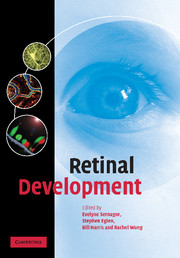Book contents
- Frontmatter
- Contents
- List of contributors
- Foreword
- Preface
- Acknowledgements
- 1 Introduction – from eye field to eyesight
- 2 Formation of the eye field
- 3 Retinal neurogenesis
- 4 Cell migration
- 5 Cell determination
- 6 Neurotransmitters and neurotrophins
- 7 Comparison of development of the primate fovea centralis with peripheral retina
- 8 Optic nerve formation
- 9 Glial cells in the developing retina
- 10 Retinal mosaics
- 11 Programmed cell death
- 12 Dendritic growth
- 13 Synaptogenesis and early neural activity
- 14 Emergence of light responses
- New perspectives
- Index
- Plate section
- References
13 - Synaptogenesis and early neural activity
Published online by Cambridge University Press: 22 August 2009
- Frontmatter
- Contents
- List of contributors
- Foreword
- Preface
- Acknowledgements
- 1 Introduction – from eye field to eyesight
- 2 Formation of the eye field
- 3 Retinal neurogenesis
- 4 Cell migration
- 5 Cell determination
- 6 Neurotransmitters and neurotrophins
- 7 Comparison of development of the primate fovea centralis with peripheral retina
- 8 Optic nerve formation
- 9 Glial cells in the developing retina
- 10 Retinal mosaics
- 11 Programmed cell death
- 12 Dendritic growth
- 13 Synaptogenesis and early neural activity
- 14 Emergence of light responses
- New perspectives
- Index
- Plate section
- References
Summary
Introduction
Once various cell types have migrated to their final location, they start synthesizing neuro–transmitters and extend neurites. At that stage, they are ready to begin forming synaptic connections with other retinal neurons. We have already seen in Chapter 6 that neurotransmitters are present before the formation of functional synapses, before electrical activity can be detected, suggesting that they play a trophic role during retinal development. However, retinal visual processing, the conversion of light into electrical signals and the relaying of these signals to the visual centres of the brain, cannot occur until neurons have established synaptic contacts with each other.
The first part of this chapter describes the formation of synaptic connections in the various retinal layers. In the last decade, important issues regarding the establishment of synaptic connections have been resolved thanks to the advent of genetic engineering and to the development of powerful specific cellular or subcellular markers, some of which are reviewed here. We put a particular emphasis on the formation of synapses between photoreceptors and second-order neurons because photoreceptors are involved in many various types of hereditary retinal degenerations. We review studies using transgenic mouse models because they provide invaluable knowledge about factors influencing photoreceptor synaptogenesis (Farber and Danciger, 1997). Understanding factors that affect synapse formation between photoreceptors and retinal neurons is crucial for reaching better insights into these devastating diseases that often lead to blindness. We will also discuss briefly the formation of gap junctions.
- Type
- Chapter
- Information
- Retinal Development , pp. 265 - 287Publisher: Cambridge University PressPrint publication year: 2006
References
- 2
- Cited by



